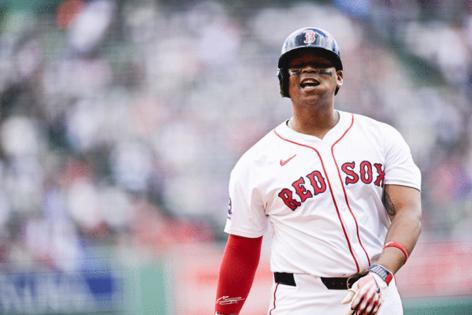Mike Vorel: With Rafael Devers trade, Giants did what Mariners won't
Published in Baseball
SEATTLE — Rafael Devers made his MLB debut against the Mariners on Aug. 25, 2017. His first hit came the next day, when Devers hammered Andrew Moore’s 90-mph fastball 427 feet off the batter’s eye. The 20-year-old prospect made a mighty first impression at T-Mobile Park.
But while the Boston Red Sox returned this week, Devers did not.
Because the San Francisco Giants were willing to do what the Mariners won’t.
Namely, take on a boatload of money to make their team better. They did so by dealing two MLB pitchers and two prospects for Devers, one of baseball’s most consistent commodities. In his past five full seasons (excluding the 2020 60-game sprint), the 28-year-old has never slashed below .271/.351/.500. He has averaged 149 games, 31.6 homers and 99.8 RBI in the same stretch.
Granted, a healthy three-time All-Star in his athletic prime shouldn’t be available. But when the Red Sox signed third baseman Alex Bregman to a three-year deal in the offseason, Devers was relieved of his defensive duties. He hesitated to embrace a role as the designated hitter, and later declined to play first base. Though Devers’ bat translates to any team, it’s accompanied by versatility and character concerns.
None of which is why the Mariners would never, ever make that move.
That, like everything else, comes down to money.
Suddenly, San Francisco is on the hook for more than $250 million of the 10-year, $313.5 million contract extension Devers signed in 2023. It’s a mighty sum for a slugger with limited defense and questionable conditioning. It’s also, given his durability and offensive aptitude, a San Francisco steal.
Can you imagine if Seattle made such a splash? If it sent four players — two MLB pitchers with ERAs of 6.47 and 4.56, respectively, plus two midlevel prospects who may never pan out — for one of baseball’s most dependable bats? For a player who sits second in MLB in both games (73) and walks (56) and gets on base at a .401 clip? For a player who could conceivably slot at third base (where the Mariners have a hole), first base (where the Mariners have a hole) or designated hitter (where the Mariners have a hole)?
For a player who could alleviate pressure from Cal Raleigh and Julio Rodríguez for the next five-plus years in the middle of the Mariners lineup?
Of course you can’t imagine it. Seeing is believing, after all.
We know how this ownership group and front office operate. They flatly refuse to pursue high-profile free agents. They prefer to draft, develop and (attempt to) extend their homegrown standouts, with Raleigh and Rodríguez being proof of process. And rather than spend on impact additions in the offseason, they’re content to tread water and try to make a splash at the trade deadline.
Devers would have been a tidal wave. But the Mariners don’t spend that kind of money. At least, not since signing Robinson Cano to a 10-year, $240 million deal in 2013. Other noteworthy investments include contracts for Rodríguez (12 years, $209.3 million), Raleigh (six years, $105 million), Robbie Ray (five years, $115 million) and Luis Castillo (five years, $108 million).
Mariners fans know better than to believe a superstar slugger is one call away.
They also know Seattle president of baseball operations Jerry Dipoto will do something at the deadline, even if that something makes a smaller splash.
“We have put ourselves in a good position as we approach the final, we’ll call it, two months leading up to the deadline,” Dipoto recently said on Seattle Sports 710 AM. “We have reached the point in the season where we have identified where our biggest needs are, and we are in the process like most teams in the league of identifying players around the league who we feel like can help us fill those voids. Fortunately for us, it’s not seven voids.
“I know we have the freedom to do it, that ownership is going to give us the flexibility to do it, and it just matters who’s available.”
So … who’s available?
That’s another issue.
It’s much more difficult to acquire proven major-league hitters at the deadline than rental relief help (another notable need). It’s also unclear how many teams will actually consider themselves sellers in a competitively crowded league.
Translation: though the Mariners need hitters, and have prospects to trade, the logical options may be limited. Orioles first baseman Ryan O’Hearn (.306/.386/.495, 10 HR, 27 RBI), Diamondbacks first baseman Josh Naylor (.300/.355/.471, 9 HR, 48 RBI) and third baseman Eugenio Suárez (.233/.307/.527, 21 HR, 57 RBI) have been floated as possible fits.
A year ago, Seattle traded for Randy Arozarena, widely considered MLB’s best available hitter. And even then, he was hitting just .211 with 15 homers and 37 RBI at the time of the trade.
At the deadline, MLB’s best hitters — not best available hitters — are unavailable.
Which makes the Mariners’ reliance on deadline additions a risky bet.
Their needs, meanwhile, are apparent as ever. In Monday’s 2-0 loss to the Red Sox, Seattle struck out 15 times and went 1 for 9 with runners in scoring position, managing four measly hits. They squandered a sparkling start from Logan Gilbert, who struck out 10 in an encouraging return from injury.
“We’re always really good when Julio and Cal get the team going. But when we pitch and hit well at the same time, just like anybody else, that’s when we really go on our runs,” Gilbert said. “I feel like we’re getting closer and closer to that.”
With the rotation getting healthy, will the Mariners hit?
Devers’ return to T-Mobile Park as a Mariner would have answered that question.
But here, in the real world? Other options will have to work.
____
©2025 The Seattle Times. Visit seattletimes.com. Distributed by Tribune Content Agency, LLC.







Comments